Pacific Surfliner
The Pacific Surfliner is a 350-mile (560 km) passenger train service serving the communities on the coast of Southern California between San Diego and San Luis Obispo.
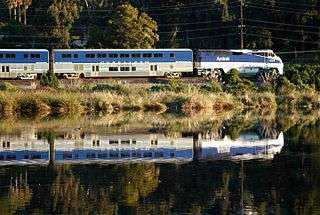 A Pacific Surfliner train in Santa Barbara, California in 2017 | ||||||||||||||||||||||||||||||||||||||||||||||||||||||||||||||||||||||||||||||||||||||||||||||||||||||||||||||||||||||||||||||||||||||||||||||||||||||||||||||||||||||||||||||||||||||||||||||||||||||||||||||||||||||||||||||||||||||||||||||||||||||||||||||||||||||||||||||||||||||||||||||||||||||||||||||||||||||||||||||||||||||||||||||||||||||||||||||||||||||||||||||||||||||||||||||||||||||||||||||||||||||||||||||||||||||||||||||||||||||
| Overview | ||||||||||||||||||||||||||||||||||||||||||||||||||||||||||||||||||||||||||||||||||||||||||||||||||||||||||||||||||||||||||||||||||||||||||||||||||||||||||||||||||||||||||||||||||||||||||||||||||||||||||||||||||||||||||||||||||||||||||||||||||||||||||||||||||||||||||||||||||||||||||||||||||||||||||||||||||||||||||||||||||||||||||||||||||||||||||||||||||||||||||||||||||||||||||||||||||||||||||||||||||||||||||||||||||||||||||||||||||||||
|---|---|---|---|---|---|---|---|---|---|---|---|---|---|---|---|---|---|---|---|---|---|---|---|---|---|---|---|---|---|---|---|---|---|---|---|---|---|---|---|---|---|---|---|---|---|---|---|---|---|---|---|---|---|---|---|---|---|---|---|---|---|---|---|---|---|---|---|---|---|---|---|---|---|---|---|---|---|---|---|---|---|---|---|---|---|---|---|---|---|---|---|---|---|---|---|---|---|---|---|---|---|---|---|---|---|---|---|---|---|---|---|---|---|---|---|---|---|---|---|---|---|---|---|---|---|---|---|---|---|---|---|---|---|---|---|---|---|---|---|---|---|---|---|---|---|---|---|---|---|---|---|---|---|---|---|---|---|---|---|---|---|---|---|---|---|---|---|---|---|---|---|---|---|---|---|---|---|---|---|---|---|---|---|---|---|---|---|---|---|---|---|---|---|---|---|---|---|---|---|---|---|---|---|---|---|---|---|---|---|---|---|---|---|---|---|---|---|---|---|---|---|---|---|---|---|---|---|---|---|---|---|---|---|---|---|---|---|---|---|---|---|---|---|---|---|---|---|---|---|---|---|---|---|---|---|---|---|---|---|---|---|---|---|---|---|---|---|---|---|---|---|---|---|---|---|---|---|---|---|---|---|---|---|---|---|---|---|---|---|---|---|---|---|---|---|---|---|---|---|---|---|---|---|---|---|---|---|---|---|---|---|---|---|---|---|---|---|---|---|---|---|---|---|---|---|---|---|---|---|---|---|---|---|---|---|---|---|---|---|---|---|---|---|---|---|---|---|---|---|---|---|---|---|---|---|---|---|---|---|---|---|---|---|---|---|---|---|---|---|---|---|---|---|---|---|---|---|---|---|---|---|---|---|---|---|---|---|---|---|---|---|---|---|---|---|---|---|---|---|---|---|---|---|---|---|---|---|---|---|---|---|---|---|---|---|---|---|---|---|---|---|---|---|---|---|---|---|---|---|---|---|---|---|---|---|---|---|---|
| Service type | Inter-city rail/Higher-speed rail | |||||||||||||||||||||||||||||||||||||||||||||||||||||||||||||||||||||||||||||||||||||||||||||||||||||||||||||||||||||||||||||||||||||||||||||||||||||||||||||||||||||||||||||||||||||||||||||||||||||||||||||||||||||||||||||||||||||||||||||||||||||||||||||||||||||||||||||||||||||||||||||||||||||||||||||||||||||||||||||||||||||||||||||||||||||||||||||||||||||||||||||||||||||||||||||||||||||||||||||||||||||||||||||||||||||||||||||||||||||
| Locale | Southern California | |||||||||||||||||||||||||||||||||||||||||||||||||||||||||||||||||||||||||||||||||||||||||||||||||||||||||||||||||||||||||||||||||||||||||||||||||||||||||||||||||||||||||||||||||||||||||||||||||||||||||||||||||||||||||||||||||||||||||||||||||||||||||||||||||||||||||||||||||||||||||||||||||||||||||||||||||||||||||||||||||||||||||||||||||||||||||||||||||||||||||||||||||||||||||||||||||||||||||||||||||||||||||||||||||||||||||||||||||||||
| Predecessor | San Diegan | |||||||||||||||||||||||||||||||||||||||||||||||||||||||||||||||||||||||||||||||||||||||||||||||||||||||||||||||||||||||||||||||||||||||||||||||||||||||||||||||||||||||||||||||||||||||||||||||||||||||||||||||||||||||||||||||||||||||||||||||||||||||||||||||||||||||||||||||||||||||||||||||||||||||||||||||||||||||||||||||||||||||||||||||||||||||||||||||||||||||||||||||||||||||||||||||||||||||||||||||||||||||||||||||||||||||||||||||||||||
| First service | June 1, 2000 | |||||||||||||||||||||||||||||||||||||||||||||||||||||||||||||||||||||||||||||||||||||||||||||||||||||||||||||||||||||||||||||||||||||||||||||||||||||||||||||||||||||||||||||||||||||||||||||||||||||||||||||||||||||||||||||||||||||||||||||||||||||||||||||||||||||||||||||||||||||||||||||||||||||||||||||||||||||||||||||||||||||||||||||||||||||||||||||||||||||||||||||||||||||||||||||||||||||||||||||||||||||||||||||||||||||||||||||||||||||
| Current operator(s) | Los Angeles – San Diego – San Luis Obispo (LOSSAN) Rail Corridor Agency, in partnership with Amtrak and Caltrans | |||||||||||||||||||||||||||||||||||||||||||||||||||||||||||||||||||||||||||||||||||||||||||||||||||||||||||||||||||||||||||||||||||||||||||||||||||||||||||||||||||||||||||||||||||||||||||||||||||||||||||||||||||||||||||||||||||||||||||||||||||||||||||||||||||||||||||||||||||||||||||||||||||||||||||||||||||||||||||||||||||||||||||||||||||||||||||||||||||||||||||||||||||||||||||||||||||||||||||||||||||||||||||||||||||||||||||||||||||||
| Ridership | 2,924,117 (FY16)[1] | |||||||||||||||||||||||||||||||||||||||||||||||||||||||||||||||||||||||||||||||||||||||||||||||||||||||||||||||||||||||||||||||||||||||||||||||||||||||||||||||||||||||||||||||||||||||||||||||||||||||||||||||||||||||||||||||||||||||||||||||||||||||||||||||||||||||||||||||||||||||||||||||||||||||||||||||||||||||||||||||||||||||||||||||||||||||||||||||||||||||||||||||||||||||||||||||||||||||||||||||||||||||||||||||||||||||||||||||||||||
| Website | Pacific Surfliner | |||||||||||||||||||||||||||||||||||||||||||||||||||||||||||||||||||||||||||||||||||||||||||||||||||||||||||||||||||||||||||||||||||||||||||||||||||||||||||||||||||||||||||||||||||||||||||||||||||||||||||||||||||||||||||||||||||||||||||||||||||||||||||||||||||||||||||||||||||||||||||||||||||||||||||||||||||||||||||||||||||||||||||||||||||||||||||||||||||||||||||||||||||||||||||||||||||||||||||||||||||||||||||||||||||||||||||||||||||||
| Route | ||||||||||||||||||||||||||||||||||||||||||||||||||||||||||||||||||||||||||||||||||||||||||||||||||||||||||||||||||||||||||||||||||||||||||||||||||||||||||||||||||||||||||||||||||||||||||||||||||||||||||||||||||||||||||||||||||||||||||||||||||||||||||||||||||||||||||||||||||||||||||||||||||||||||||||||||||||||||||||||||||||||||||||||||||||||||||||||||||||||||||||||||||||||||||||||||||||||||||||||||||||||||||||||||||||||||||||||||||||||
| Start | San Luis Obispo, California | |||||||||||||||||||||||||||||||||||||||||||||||||||||||||||||||||||||||||||||||||||||||||||||||||||||||||||||||||||||||||||||||||||||||||||||||||||||||||||||||||||||||||||||||||||||||||||||||||||||||||||||||||||||||||||||||||||||||||||||||||||||||||||||||||||||||||||||||||||||||||||||||||||||||||||||||||||||||||||||||||||||||||||||||||||||||||||||||||||||||||||||||||||||||||||||||||||||||||||||||||||||||||||||||||||||||||||||||||||||
| Stops | 25 | |||||||||||||||||||||||||||||||||||||||||||||||||||||||||||||||||||||||||||||||||||||||||||||||||||||||||||||||||||||||||||||||||||||||||||||||||||||||||||||||||||||||||||||||||||||||||||||||||||||||||||||||||||||||||||||||||||||||||||||||||||||||||||||||||||||||||||||||||||||||||||||||||||||||||||||||||||||||||||||||||||||||||||||||||||||||||||||||||||||||||||||||||||||||||||||||||||||||||||||||||||||||||||||||||||||||||||||||||||||
| End | San Diego, California | |||||||||||||||||||||||||||||||||||||||||||||||||||||||||||||||||||||||||||||||||||||||||||||||||||||||||||||||||||||||||||||||||||||||||||||||||||||||||||||||||||||||||||||||||||||||||||||||||||||||||||||||||||||||||||||||||||||||||||||||||||||||||||||||||||||||||||||||||||||||||||||||||||||||||||||||||||||||||||||||||||||||||||||||||||||||||||||||||||||||||||||||||||||||||||||||||||||||||||||||||||||||||||||||||||||||||||||||||||||
| Distance travelled | 350 miles (563 km) | |||||||||||||||||||||||||||||||||||||||||||||||||||||||||||||||||||||||||||||||||||||||||||||||||||||||||||||||||||||||||||||||||||||||||||||||||||||||||||||||||||||||||||||||||||||||||||||||||||||||||||||||||||||||||||||||||||||||||||||||||||||||||||||||||||||||||||||||||||||||||||||||||||||||||||||||||||||||||||||||||||||||||||||||||||||||||||||||||||||||||||||||||||||||||||||||||||||||||||||||||||||||||||||||||||||||||||||||||||||
| Average journey time | 8 hours 15 minutes | |||||||||||||||||||||||||||||||||||||||||||||||||||||||||||||||||||||||||||||||||||||||||||||||||||||||||||||||||||||||||||||||||||||||||||||||||||||||||||||||||||||||||||||||||||||||||||||||||||||||||||||||||||||||||||||||||||||||||||||||||||||||||||||||||||||||||||||||||||||||||||||||||||||||||||||||||||||||||||||||||||||||||||||||||||||||||||||||||||||||||||||||||||||||||||||||||||||||||||||||||||||||||||||||||||||||||||||||||||||
| Train number(s) | 561–595, 759–796, 1566–1590, 1761, 1767 | |||||||||||||||||||||||||||||||||||||||||||||||||||||||||||||||||||||||||||||||||||||||||||||||||||||||||||||||||||||||||||||||||||||||||||||||||||||||||||||||||||||||||||||||||||||||||||||||||||||||||||||||||||||||||||||||||||||||||||||||||||||||||||||||||||||||||||||||||||||||||||||||||||||||||||||||||||||||||||||||||||||||||||||||||||||||||||||||||||||||||||||||||||||||||||||||||||||||||||||||||||||||||||||||||||||||||||||||||||||
| On-board services | ||||||||||||||||||||||||||||||||||||||||||||||||||||||||||||||||||||||||||||||||||||||||||||||||||||||||||||||||||||||||||||||||||||||||||||||||||||||||||||||||||||||||||||||||||||||||||||||||||||||||||||||||||||||||||||||||||||||||||||||||||||||||||||||||||||||||||||||||||||||||||||||||||||||||||||||||||||||||||||||||||||||||||||||||||||||||||||||||||||||||||||||||||||||||||||||||||||||||||||||||||||||||||||||||||||||||||||||||||||||
| Class(es) | Coach Class (unreserved); Business Class (reserved) | |||||||||||||||||||||||||||||||||||||||||||||||||||||||||||||||||||||||||||||||||||||||||||||||||||||||||||||||||||||||||||||||||||||||||||||||||||||||||||||||||||||||||||||||||||||||||||||||||||||||||||||||||||||||||||||||||||||||||||||||||||||||||||||||||||||||||||||||||||||||||||||||||||||||||||||||||||||||||||||||||||||||||||||||||||||||||||||||||||||||||||||||||||||||||||||||||||||||||||||||||||||||||||||||||||||||||||||||||||||
| Catering facilities | Market Café Car | |||||||||||||||||||||||||||||||||||||||||||||||||||||||||||||||||||||||||||||||||||||||||||||||||||||||||||||||||||||||||||||||||||||||||||||||||||||||||||||||||||||||||||||||||||||||||||||||||||||||||||||||||||||||||||||||||||||||||||||||||||||||||||||||||||||||||||||||||||||||||||||||||||||||||||||||||||||||||||||||||||||||||||||||||||||||||||||||||||||||||||||||||||||||||||||||||||||||||||||||||||||||||||||||||||||||||||||||||||||
| Technical | ||||||||||||||||||||||||||||||||||||||||||||||||||||||||||||||||||||||||||||||||||||||||||||||||||||||||||||||||||||||||||||||||||||||||||||||||||||||||||||||||||||||||||||||||||||||||||||||||||||||||||||||||||||||||||||||||||||||||||||||||||||||||||||||||||||||||||||||||||||||||||||||||||||||||||||||||||||||||||||||||||||||||||||||||||||||||||||||||||||||||||||||||||||||||||||||||||||||||||||||||||||||||||||||||||||||||||||||||||||||
| Rolling stock | GE P42DC and Siemens Charger locomotives Surfliner and Superliner coaches | |||||||||||||||||||||||||||||||||||||||||||||||||||||||||||||||||||||||||||||||||||||||||||||||||||||||||||||||||||||||||||||||||||||||||||||||||||||||||||||||||||||||||||||||||||||||||||||||||||||||||||||||||||||||||||||||||||||||||||||||||||||||||||||||||||||||||||||||||||||||||||||||||||||||||||||||||||||||||||||||||||||||||||||||||||||||||||||||||||||||||||||||||||||||||||||||||||||||||||||||||||||||||||||||||||||||||||||||||||||
| Track gauge | 1,435 mm (4 ft 8 1⁄2 in) | |||||||||||||||||||||||||||||||||||||||||||||||||||||||||||||||||||||||||||||||||||||||||||||||||||||||||||||||||||||||||||||||||||||||||||||||||||||||||||||||||||||||||||||||||||||||||||||||||||||||||||||||||||||||||||||||||||||||||||||||||||||||||||||||||||||||||||||||||||||||||||||||||||||||||||||||||||||||||||||||||||||||||||||||||||||||||||||||||||||||||||||||||||||||||||||||||||||||||||||||||||||||||||||||||||||||||||||||||||||
| Operating speed | 90 mph (145 km/h) (top) 41.2 mph (66.3 km/h) (average) | |||||||||||||||||||||||||||||||||||||||||||||||||||||||||||||||||||||||||||||||||||||||||||||||||||||||||||||||||||||||||||||||||||||||||||||||||||||||||||||||||||||||||||||||||||||||||||||||||||||||||||||||||||||||||||||||||||||||||||||||||||||||||||||||||||||||||||||||||||||||||||||||||||||||||||||||||||||||||||||||||||||||||||||||||||||||||||||||||||||||||||||||||||||||||||||||||||||||||||||||||||||||||||||||||||||||||||||||||||||
| ||||||||||||||||||||||||||||||||||||||||||||||||||||||||||||||||||||||||||||||||||||||||||||||||||||||||||||||||||||||||||||||||||||||||||||||||||||||||||||||||||||||||||||||||||||||||||||||||||||||||||||||||||||||||||||||||||||||||||||||||||||||||||||||||||||||||||||||||||||||||||||||||||||||||||||||||||||||||||||||||||||||||||||||||||||||||||||||||||||||||||||||||||||||||||||||||||||||||||||||||||||||||||||||||||||||||||||||||||||||
The service carried 2,924,117 passengers during fiscal year 2016, a 3.4% increase from FY2015. Total revenue during FY2016 was $73,020,267, an increase of 3.6% over FY2015.[1] The Pacific Surfliner is Amtrak's third-busiest service (exceeded in ridership only by the Northeast Regional and Acela Express), and the busiest outside the Northeast Corridor.[1]
Like all regional trains in California, the Pacific Surfliner is operated by a joint powers authority. The Los Angeles – San Diego – San Luis Obispo (LOSSAN) Rail Corridor Agency is governed by a board that includes eleven elected representatives from the six counties the train travels through. LOSSAN contracts with the Orange County Transportation Authority to provide day-to-day management of the service and with contracts with Amtrak to operate the service and maintain the rolling stock (locomotives and passenger cars). The California Department of Transportation (Caltrans) provides the funding to operate the service and also owns most of the rolling stock. The Surfliner coaches, primarily used on the Pacific Surfliner, are named after it.
Operations
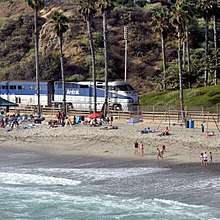
The 350-mile (563 km) San Luis Obispo-San Diego trip takes approximately 8½ hours with an average speed of 41.2 miles per hour (66 km/h); maximum track speed is 79 to 90 miles per hour (127 to 145 km/h). Much of the Pacific Surfliner's scenic route follows the Pacific coast, with the tracks being less than 100 feet from the ocean in some locations. However, trains travel inland through expansive farmlands in Ventura County and industrial backlots in the Los Angeles Basin, San Fernando Valley, and parts of Orange County.
The Pacific Surfliner operates thirteen daily round trips between Los Angeles and San Diego. Five round trips run north of Los Angeles: two to San Luis Obispo, and three to Goleta with Thruway Motorcoach connections to San Luis Obispo. Thruway Motorcoach connections are also available to San Pedro; to Palm Springs and Indio; and to San Jose or Oakland (with connections to Capitol Corridor trains) via Paso Robles.
Because the San Luis Obispo and Goleta stations are not designed to turn equipment, and the San Diego Santa Fe Depot requires a time-consuming deadhead movement into a wye located about 16 miles to the north in Miramar, trains are operated in push-pull mode. The locomotive is at the rear of the train, pushing the train from Goleta, San Luis Obispo or San Diego to Los Angeles. At Los Angeles, the train reverses at the station, and the locomotive pulls the train to San Diego or Goleta/San Luis Obispo, respectively. Run-through tracks are proposed at Union Station in Los Angeles to ease congestion and reduce time spent waiting to enter or depart the station.[2]
LOSSAN
Local agencies along with the host railroads formed the Los Angeles–San Diego-San Luis Obispo Rail Corridor Agency (LOSSAN) in 1989.[3] The Pacific Surfliner is operated by Amtrak under the Amtrak California brand with funding provided by the California Department of Transportation (Caltrans). Serious discussions were held in 2009 regarding the local agencies administering the service rather than Caltrans.[4] California Senate Bill No. 1225, passed in 2014, allowed LOSSAN to amend the joint powers agreement and become the sponsor of state-supported intercity passenger rail service in the corridor.[5] In mid-2015, LOSSAN assumed oversight for the Surfliner.[6] They are also working with Caltrans to assess rail operations from Los Angeles to San Diego to develop better connections, close gaps in the schedule, and optimize the assets of the railroad.[7] The ongoing North Coast Corridor project plans to increase rail capacity on the route of the Surfliner in North San Diego County.
History
The route is the successor of the San Diegan, a Los Angeles-San Diego service operated since 1938 by the Santa Fe Railway. It had been one of the Santa Fe's premier routes until Amtrak took over operations in 1971. Initially there were three daily trips, but the schedule was expanded to six round trips during the 1970s with funding from the state of California. In 1988 the service was extended to Santa Barbara to provide the Central Coast with an additional train to Los Angeles, followed in 1995 with one trip a day going all the way to San Luis Obispo. To better reflect the route's extent, it was renamed the Pacific Surfliner in 2000.[8] The route is named after the Surf Line, which now comprises the route's busiest section from Los Angeles to San Diego.
A stop at Old Town Transit Center was added in 2004. Stops at Orange and Laguna Niguel/Mission Viejo were added in 2007 but dropped in 2012. On October 7, 2013, stops were added at Coaster stations at Carlsbad Village, Carlsbad Poinsettia, Encinitas and Sorrento Valley.[9] The Carlsbad Poinsettia and Encinitas stops were dropped on October 9, 2017 due to low ridership.[10] The Carlsbad Village and Sorrento Valley stops were dropped on October 8, 2018 due to changes with the cross-ticketing arrangement with Coaster.[11]
A 13th daily round trip was added on October 14, 2019.[12]
Route
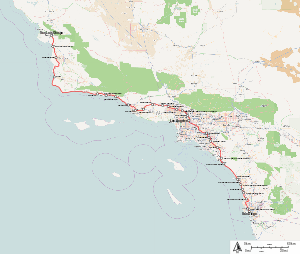
The Pacific Surfliner runs on track owned by several private railroads and public agencies:
- Union Pacific Railroad: San Luis Obispo – Moorpark (Coast Line)
- Southern California Regional Rail Authority: Moorpark – Los Angeles
- BNSF Railway: Los Angeles – Fullerton
- Southern California Regional Rail Authority: Fullerton – Orange County/San Diego County line
- North County Transit District: Orange County/San Diego County line – San Diego
Stations
| † | Station no longer served |
| ♦ | Limited service, not all trains stop at this station |
| Station | Location | Connections |
|---|---|---|
| San Luis Obispo | San Luis Obispo | Amtrak: Coast Starlight Amtrak Thruway Motorcoach to Santa Barbara, San Jose, San Francisco, Oakland[13] SLO Transit Orange Belt Stages |
| Grover Beach | Grover Beach | Amtrak Thruway Motorcoach to Santa Barbara, San Jose, San Francisco, Oakland South County Transit |
| Guadalupe | Guadalupe | Amtrak Thruway Motorcoach to San Jose, San Francisco, Oakland Guadalupe Flyer |
| Lompoc–Surf | Surf | |
| Goleta | Goleta | |
| Santa Barbara | Santa Barbara | Amtrak: Coast Starlight Amtrak Thruway Motorcoach to Los Angeles, UCSB, San Jose, San Francisco, Oakland[13] MTD Santa Barbara |
| Carpinteria | Carpinteria | Amtrak Thruway Motorcoach to Los Angeles, UCSB[13] MTD Santa Barbara |
| Ventura | Ventura | |
| Oxnard Transit Center | Oxnard | Amtrak: Coast Starlight Metrolink: Ventura County Line Amtrak Thruway Motorcoach to Los Angeles, UCSB[13] Gold Coast Transit |
| Camarillo ♦ | Camarillo | Metrolink: Ventura County Line Amtrak Thruway Motorcoach to UCSB[13] VCTC Intercity |
| Moorpark ♦ | Moorpark | Metrolink: Ventura County Line Amtrak Thruway Motorcoach to UCSB[13] Moorpark City Transit VCTC Intercity |
| Simi Valley | Simi Valley | Amtrak: Coast Starlight Metrolink: Ventura County Line Amtrak Thruway Motorcoach to UCSB[13] Simi Valley Transit |
| Chatsworth | Los Angeles | Metrolink: Ventura County Line Amtrak Thruway Motorcoach to UCSB[13] LADOT Commuter Express Metro Busway: G Line (Orange) Metro Local Santa Clarita Transit |
| Van Nuys | Amtrak: Coast Starlight Metrolink: Ventura County Line Amtrak Thruway Motorcoach to UCSB[13] Metro Rapid Metro Local LADOT DASH | |
| Hollywood Burbank Airport | Burbank | Amtrak: Coast Starlight Metrolink: Ventura County Line Metro Local |
| Glendale | Glendale | Metrolink: Antelope Valley Line, Ventura County Line Amtrak Thruway Motorcoach to UCSB[13] Metro Rapid Metro Local Glendale Beeline Greyhound Lines |
| Union Station | Los Angeles | |
| Fullerton | Fullerton | Amtrak: Southwest Chief Metrolink: 91/Perris Valley Line, Orange County Line Amtrak Thruway Motorcoach to Palm Springs, Indio[13] Orange County Transportation Authority |
| Anaheim | Anaheim | Metrolink: Orange County Line Orange County Transportation Authority Anaheim Resort Transportation Flixbus Greyhound Lines |
| Orange † | Orange | |
| Santa Ana | Santa Ana | Metrolink: Inland Empire-Orange County Line, Orange County Line Orange County Transportation Authority Greyhound Lines |
| Irvine | Irvine | Metrolink: Inland Empire-Orange County Line, Orange County Line Orange County Transportation Authority iShuttle |
| Laguna Niguel/Mission Viejo † | Laguna Niguel | |
| San Juan Capistrano | San Juan Capistrano | Metrolink: Inland Empire-Orange County Line, Orange County Line |
| San Clemente Pier ♦ | San Clemente | Metrolink: Inland Empire-Orange County Line, Orange County Line |
| Oceanside | Oceanside | North County Transit District: Coaster, Sprinter Metrolink: Inland Empire-Orange County Line, Orange County Line Riverside Transit Agency |
| Carlsbad Village † | Carlsbad | |
| Carlsbad Poinsettia † | ||
| Encinitas † | Encinitas | |
| Solana Beach | Solana Beach | North County Transit District: Coaster |
| Sorrento Valley † | San Diego | |
| Old Town Transit Center | North County Transit District: Coaster San Diego Trolley: Green Line Metropolitan Transit System | |
| Santa Fe Depot | North County Transit District: Coaster San Diego Trolley: Green Line, Blue Line, Orange Line, Silver Line Metropolitan Transit System |
Rolling stock
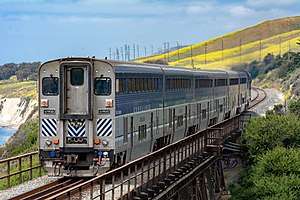
The Pacific Surfliner uses push-pull trainsets with a diesel locomotive at one end and a cab car at the other. Eight of the nine trainsets used for regular service use a fleet of 49 bilevel Surfliner coaches (39 owned by Amtrak and 10 by Caltrans), plus nine leased Amtrak Superliner long-distance coaches modified for push-pull operation. A typical six-car set has a business class car; three coach cars; a coach/café car with food sales on the lower level; and a coach/baggage/cab car equipped with coach seating, a checked baggage space on the lower level, and engineer's operating cab.[14] The ninth trainset consists of leased Amtrak equipment: Horizon or Amfleet passenger cars plus a Non-Powered Control Unit.[14] The Surfliner cars will be supplemented and partially replaced by new Siemens single-level cars beginning in 2020.[14] In 2018, to provide additional capacity before the new cars arrive, LOSSAN began negotiating with the Great Lakes Central Railroad to lease bilevel railcars previously refurbished for a never-opened commuter railroad in Michigan.[14]
The Surfliner cars were introduced in 2000-02, and were designed specifically to handle the demands of the nation's third-busiest rail line.[15] They replaced the California Cars which had been introduced on the then-San Diegan in 1996, and had been fraught with problems in the latter part of the 1990s.[16]
A dedicated fleet of 14 Caltrans-owned Siemens Charger locomotives began pre-revenue testing in October 2018 and entered revenue service later that year.[17][18] The Chargers replaced a fleet of 15 Amtrak-owned EMD F59PHI locomotives (built in 1998), which were sold to Metra in early 2018.[19][20][14][21] Amtrak-owned GE P42DC locomotives (which are also used at other times) were temporarily used as motive power until the Chargers were ready for service. The Surfliner cars and Charger locomotives (and previously the F59PHI locomotives) are painted in a blue and silver livery that is unique to the Pacific Surfliner.[22][23]
Additional Amtrak-owned cars are added (up to 12-car consists) during periods of high demand, including the San Diego Comic-Con, the San Diego County Fair, events at the Del Mar racetrack, and after the 2018 Southern California mudflows closed Highway 101.[24][25] Amtrak Great Dome car Ocean View is occasionally used as an additional business class car.[26]
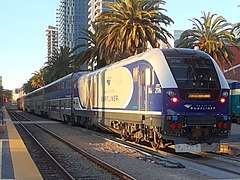 A typical bilevel consist with a new Charger locomotive in 2019
A typical bilevel consist with a new Charger locomotive in 2019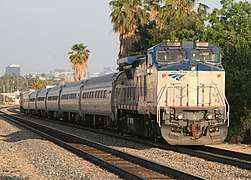 A typical single-level consist in 2010
A typical single-level consist in 2010- Lower-level seating on a "Pacific Business Class" car in 2012
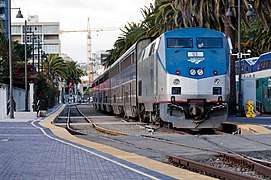 A Pacific Surfliner train hauled by a P42DC locomotive in 2012
A Pacific Surfliner train hauled by a P42DC locomotive in 2012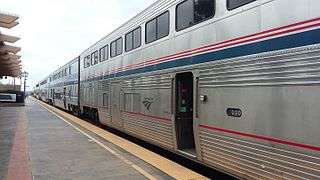 A Superliner car used in 2016
A Superliner car used in 2016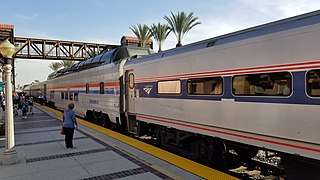 Ocean View on the Pacific Surfliner in 2017
Ocean View on the Pacific Surfliner in 2017
References
- "Amtrak FY16 Ridership and Revenue Fact Sheet" (PDF). Amtrak. April 17, 2017. Retrieved February 21, 2018.
- "SCRIP - The Southern California Regional Interconnection Project". Los Angeles County Metropolitan Transportation Authority. Archived from the original on April 17, 2016. Retrieved May 8, 2016.
- "LOSSAN Corridorwide Strategic Implementation Plan, Final Report (April 2012)" (PDF). San Luis Obispo Council of Governments. Retrieved April 24, 2018.
- "LOSSAN Board discusses JPA and the Future Governance of Passenger Rail in Southern California". Rail Passenger Association of California & Nevada. Retrieved December 6, 2009.
- "Senate Bill No. 1225" California Secretary of State (September 29, 2012)
- Sheehan, Tim (June 26, 2015). "Valley agency takes control of Amtrak San Joaquin trains". Fresno Bee. Retrieved February 11, 2016.
- Weikel, Dan (January 27, 2015) "Little-known agency keeps commuter rail network on track" Los Angeles Times
- Gabbard, Dana (September 24, 2012). "History of the Surfliner, LOSSAN and a Look at Pending Legislation". StreetsBlog LA. OpenPlans. Retrieved April 11, 2014.
- "Amtrak Pacific Surfliner Adds Four New stops" (Press release). Amtrak. September 18, 2013.
- Diehl, Phil (September 21, 2017). "Amtrak to discontinue two stops, add one". San Diego Union Tribune.
- "October 8, 2018 Schedule Change" (Press release). Amtrak. Archived from the original on November 26, 2018.
- "AMTRAK PACIFIC SURFLINER INTRODUCES 13TH ROUNDTRIP" (Press release). Amtrak. October 10, 2019.
- "Pacific Surfliner". Amtrak. October 14, 2019. Retrieved April 12, 2020.
- "Chapter 9: Equipment". LOSSAN Rail Corridor Agency Business Plan: FY 2018-19 to FY 2019-20 (PDF). Los Angeles – San Diego – San Luis Obispo Rail Corridor Agency. April 2018. pp. 41–47.
- Alstom. "The Pacific Surfliner, Riding the California Coast" (PDF). Archived from the original (PDF) on April 7, 2014. Retrieved April 2, 2014.
- "STATE RAILROAD CARS PLAGUED WITH DEFECTS". Daily News. Los Angeles, CA. Associated Press. April 13, 1998. Retrieved December 30, 2019.
- "New, Cleaner Locomotives Coming Soon to the Amtrak Pacific Surfliner Service". Pacific Surfliner Blog. October 5, 2018. Retrieved November 29, 2018.
- "Charger Locomotive Deployment: 'The California Experience'" (PDF). Next Generation Equipment Committee - 2019 Annual Meeting. American Association of State Highway and Transportation Officials. February 22, 2019.
- "Cleaner Locomotive Fleet Powers Up: 22 New Units Ordered for State-Supported Amtrak Corridors" (PDF). The Mile Marker. Caltrans. December 2016. pp. 31–32.
- Young, Allen (November 6, 2015). "Siemens Sacramento nabs $240M multistate contract". Sacramento Business Journal.
- "Metra moves to buy newer engines" (Press release). Metra. February 21, 2018.
- "Official Paint Scheme and Logo Branding Guide" (PDF). Amtrak. August 17, 2018. Archived (PDF) from the original on September 18, 2018.
- Solomon, Brian (2004). Amtrak. Saint Paul, Minnesota: MBI. pp. 114, 138. ISBN 978-0-7603-1765-5.
- "EXTRA PACIFIC SURFLINER SERVICE AND CAPACITY ADDED FOR COMIC-CON". Pacific Surfliner Blog. Amtrak. July 11, 2018.
- "Amtrak boosts Pacific Surfliner capacity in response to mudslides". Progressive Railroading. January 16, 2018.
- "PANORAMIC VIEWS OF THE CALIFORNIA COAST FROM THE GREAT DOME". Pacific Surfliner Blog. Amtrak. July 14, 2017.
External links
| Wikimedia Commons has media related to Pacific Surfliner. |